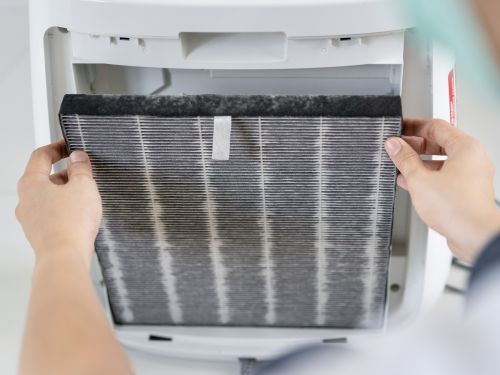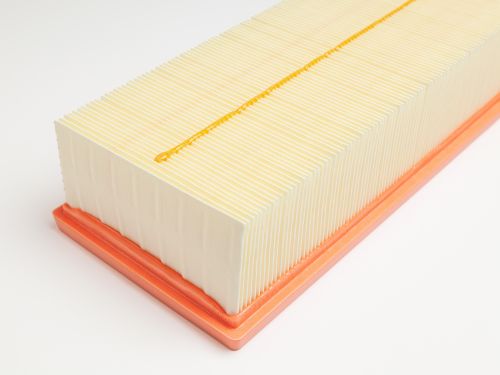Improving Indoor Air Quality with the Right Air Filter
Choosing the right air filter is one of the most important steps in improving indoor air quality and ensuring your HVAC system runs efficiently. With so many options available—HEPA, pleated, fiberglass, electrostatic, and more—homeowners often feel overwhelmed when selecting the best filter for their needs. Understanding the different air filter types, their efficiency ratings, and recommended replacement schedules can help you make an informed decision that keeps your home comfortable and your air clean.
Let’s break down the most common HVAC air filter types, how they work, and what to consider when choosing the right filter for your heating and cooling system.


Want Help with Choosing the Best Air Filter for Your Home?
Understanding Air Filter Ratings: MERV, HEPA & Efficiency
Before diving into specific filter types, it’s important to understand how air filter efficiency is measured.
MERV Rating
MERV (Minimum Efficiency Reporting Value) measures how effectively a filter captures particles. Ratings range from 1 to 20:
- MERV 1–4: Basic filtration, captures large dust particles
- MERV 5–8: Standard home use, captures dust, pollen, mold spores
- MERV 9–12: Higher efficiency, captures smaller particles such as pet dander
- MERV 13–16: Hospital-grade filtration capable of capturing bacteria
- MERV 17–20: Specialized filters (HEPA-level)
Higher MERV ratings offer better filtration but may restrict airflow if your HVAC system is not designed for them. Always check your system’s manufacturer guidelines.
HEPA (High Efficiency Particulate Air)
HEPA filters trap 99.97% of particles as small as 0.3 microns. While ideal for air purifiers and medical environments, most central HVAC systems are not built to handle HEPA filters due to their density.
Common Types of Air Filters
Fiberglass Filters
Fiberglass filters are the most affordable and commonly used in basic HVAC systems. They offer low-resistance airflow and protect the system from large dust particles.
Pros
- Inexpensive
- Good airflow
- Basic HVAC protection
Cons
- Low filtration efficiency
- Does not effectively remove allergens
Replacement Schedule: Every 30 days
Pleated Air Filters
Pleated filters are made from polyester or cotton and offer a significant upgrade over fiberglass filters. Their larger surface area allows them to trap smaller particles, improving indoor air quality.
Pros
- Better filtration of dust, pollen, and mold spores
- Available in MERV 8–13
- Long-lasting
Cons
- Slightly higher cost
- Higher-density filters may reduce airflow if not compatible with your HVAC system
Replacement Schedule: Every 60–90 days depending on home conditions
HEPA Filters
HEPA filters offer the highest filtration efficiency, capturing smoke, bacteria, viruses, and microscopic debris. These are often used in standalone air purifiers, not central HVAC systems, unless your system is specifically designed for HEPA compatibility.
Pros
- Superior filtration
- Ideal for allergy and asthma sufferers
- Captures ultrafine particles
Cons
- Not compatible with most HVAC systems
- Expensive
- May require professional installation
Replacement Schedule: Every 6–12 months depending on usage
Electrostatic Filters
Electrostatic filters use static electricity to attract and capture airborne particles. They come in both disposable and washable options.
Pros
- Excellent at removing smoke, dust, and allergens
- Reusable versions reduce long-term cost
- Good airflow performance
Cons
- Must be cleaned regularly
- Washable versions lose efficiency over time
Replacement Schedule: Disposable: every 90 days | Washable: clean monthly, replace every 2–3 years
Activated Carbon Filters
These filters contain activated charcoal that removes odors, smoke, and chemical fumes. They are often paired with other filter types.
Pros
- Excellent odor control
- Reduces VOCs and gases
- Ideal for homes with pets or smokers
Cons
- Must be combined with another filter to remove dust
- Needs frequent replacement
Replacement Schedule: Every 60–90 days.
How to Choose the Right Air Filter
Choosing the right filter depends on several factors:
1. Household Needs
- Allergies or asthma: Choose a pleated or HEPA-level filter
- Pets: A filter with a MERV 10+ rating
- Smokers or strong odors: Activated carbon filter
- Basic use: Standard pleated or fiberglass
2. HVAC System Compatibility
Higher-MERV filters restrict airflow. Always follow manufacturer guidelines to avoid damaging your system.
3. Home Environment
Dusty areas, high-pollen regions, and homes with multiple occupants may require more frequent filter changes.
4. Budget Considerations
Pleated and electrostatic filters offer the best value for long-term performance.
Let’s Improve Your Indoor Air Quality, Choose the Right Air Filter
Understanding the different air filter types—HEPA, pleated, fiberglass, and electrostatic—helps you make informed decisions that support better indoor air quality and HVAC efficiency. Selecting the right filter keeps your home cleaner, reduces allergens, and extends the lifespan of your HVAC system.
Need help finding the best air filter for your home? Contact Better Air Northwest today for personalized recommendations and expert installation.

